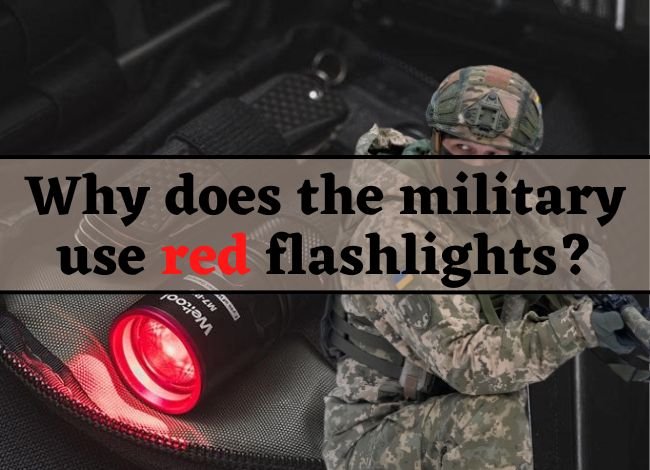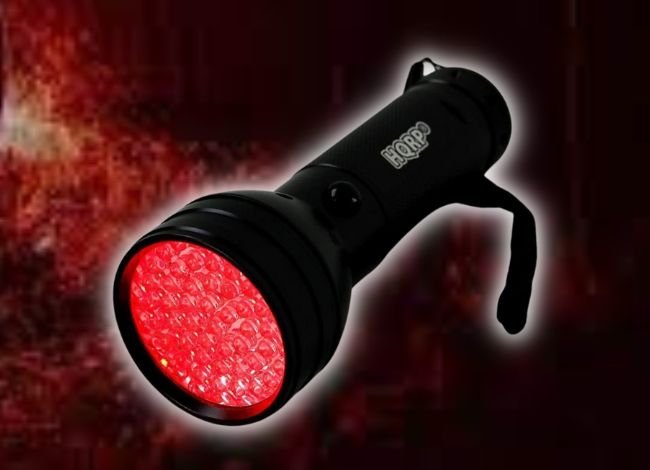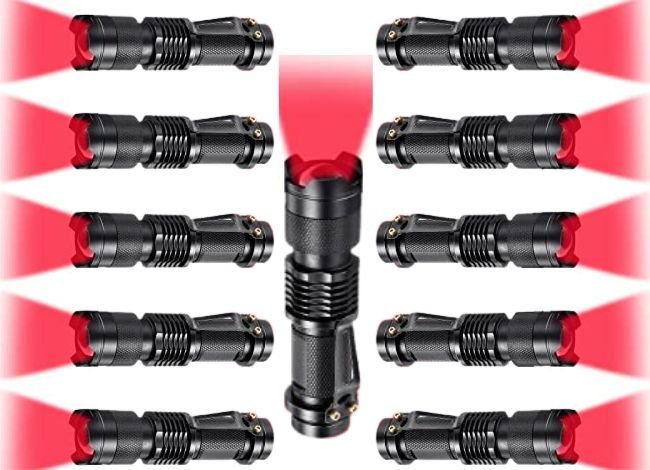Last Updated on May 26, 2025

Flashlights are essential tools for both civilians and military personnel, but not all lights are created equal. In military operations, especially during nighttime missions, a specific type of flashlight often stands out—the red flashlight.
So, why military use red flashlights instead of traditional white lights?
The answer lies in a combination of stealth, efficiency, and eye protection. Red light helps preserve night vision, reduces detection risk, and enhances tactical communication. Whether you’re a soldier, hunter, or camper, understanding the unique role of red flashlights can help you make better lighting choices.
Preserving Night Vision: The Core Reason
When your eyes adjust to the dark, your pupils dilate, and a chemical called rhodopsin builds up in your eyes, allowing you to see in low-light conditions. Bright white light breaks down this chemical, forcing your eyes to readjust—a process that can take up to 30 minutes.
Red light, on the other hand, has a longer wavelength that doesn’t affect rhodopsin levels as much, allowing military personnel to move in and out of light without losing their ability to see in the dark. That’s a game-changer for surveillance, navigation, or combat missions.
Stealth Mode: Low Light Signature
Red light is harder to detect from a distance, especially through night vision goggles or from aerial views. This makes it perfect for:
- Avoiding detection by enemies
- Concealing movements in low-light missions
- Using equipment discreetly at night
A red flashlight produces a low-light signature, which significantly reduces visibility to enemy forces or tracking devices.
Tactical Signaling and Communication
In the military, red lights are often used as signals during missions. A soldier may flash a red light to indicate:
- “Friendly presence” to other team members
- A silent signal to move forward or hold position
- An emergency or caution alert
This non-verbal communication method helps in silent coordination, especially in scenarios where speaking could compromise the mission.
Better Performance in Fog and Dust
Unlike white light, which can reflect off particles in fog or dust and cause glare, red light penetrates these elements more efficiently, offering clearer visibility. That makes red flashlights particularly useful in:
- Desert patrols
- Dusty battlefields
- Smoky rescue operations
Helmet-Mounted and Hands-Free Use
Red flashlights come in various formats, including helmet-mounted lights and headlamps, allowing soldiers to:
- Use both hands while navigating or engaging targets
- Work with maps or gear in total darkness
- Reduce arm fatigue from holding a handheld light
These configurations are favored during combat, medical aid, or survival operations.
Are Red Flashlights Useful for Civilians?
Absolutely. Red flashlights are becoming popular among:

- Hunters: Less likely to spook wildlife
- Campers: Ideal for reading or setting up camp at night
- Astronomers: Preserve night vision while adjusting telescopes
- Photographers: Subtle lighting without ruining a night shot
- Emergency responders: Reduced eye strain and better focus
Even for urban use, such as power outages or emergency signaling, red flashlights offer a non-intrusive alternative to traditional lighting.
Red Flashlight vs. White Flashlight: Quick Comparison
| Feature | Red Flashlight | White Flashlight |
|---|---|---|
| Preserves Night Vision | ✔ Yes | ❌ No |
| Visibility to Enemies | ✔ Low detection | ❌ Easily noticeable |
| Ideal for Hunting | ✔ Yes | ❌ No |
| Eye Adjustment Time | ✔ Fast | ❌ Slow |
| Non-Verbal Signaling | ✔ Effective | ❌ Not ideal |
| Light Pollution | ✔ Minimal | ❌ High |
| Civilian Use | ✔ Growing in popularity | ✔ Widely used |
Environmental and Tactical Advantages
a) Less Light Pollution
Red LEDs emit lower intensity light, reducing light pollution, which helps soldiers maintain stealth and avoid detection by drones or thermal sensors.
b) Less Startling to Wildlife
White light can startle or agitate animals, while red light is less invasive, making it ideal for military jungle operations or hunting.
c) Energy Efficiency
Red lights consume less power, allowing for longer battery life—vital in missions where charging is not an option.
Advantages of Red Light Headlamps
- Hands-Free Operation: Ideal for soldiers, mechanics, hikers, and cyclists
- Night Readiness: Perfect for camp setup or map reading
- Stealth Mobility: Move without disturbing your environment
- Enhanced Precision: Focused red beams offer better clarity in short-range work
Are Red Flashlights Suitable for Hunters?
Yes! Hunters benefit immensely from red flashlights for these reasons:
- Do not spook prey like deer or hogs
- Provide better target tracking
- Help distinguish between blood trails and foliage
- Reduce exposure to insect attraction (compared to blue or white light)
Popular Red Flashlights in 2025
Red LED Flashlight Mini – 3 Modes Zoomable Hunting Light
Features:
- Lightweight & waterproof
- Zoomable focus
- Compact for pocket or tactical bag
- Best for: Hunting, Camping, Emergency Kits
UltraFire Tactical LED A100
Features:
- 5 Light Modes: Low, Medium, High, Strobe, SOS
- Dual battery compatibility (Rechargeable 18650 or AAA)
- Durable aluminum body
- Best for: Military trainees, Preppers, Night Patrol
How to Choose the Best Red Flashlight
Before purchasing, consider the following:
| Factor | Why It Matters |
|---|---|
| Battery Life | Long missions need extended power |
| Brightness Modes | Adjustable levels for various tasks |
| Mounting Options | Helmet, gun, or belt mount compatibility |
| Build Material | Aluminum or aircraft-grade steel for durability |
| Size and Portability | Compact and lightweight for easy carry |
| Water Resistance | IPX6 or higher for field operations |
When NOT to Use a Red Flashlight
- For detailed repairs requiring full-color visibility
- During daytime tasks where brightness is more important than stealth
- In roadside emergencies, where visibility to others is critical
In these situations, a high-lumen white flashlight is a better fit.
Why Military Use Red Flashlights in Tactical Situations
Red flashlights are commonly used by the military because they preserve night vision, reduce detection by enemies, and prevent disrupting maps or sensitive equipment. Unlike white light, red light allows soldiers to see in the dark without giving away their position. That’s exactly why military use red flashlights during covert operations and nighttime missions.
Frequently Asked Questions (FAQs)
Q1: Why is red light better than white for night vision?
Red light helps preserve rhodopsin in the eye, allowing faster adjustment to dark surroundings.
Q2: Can civilians buy tactical red flashlights?
Yes, red flashlights are legal and widely available for civilian use.
Q3: Is red or green light better for hunting?
Red is better for preserving night vision, while green provides better contrast for spotting details.
Q4: Does red light scare animals?
No, most wildlife is less sensitive to red light, making it ideal for jungle patrols and hunting.
Q5: Can red flashlights be used for stargazing?
Absolutely! Red flashlights are perfect for stargazing as they reduce light pollution and preserve dark adaptation.
Conclusion: The Tactical Edge of Red Flashlights
From preserving night vision to enhancing stealth and communication, red flashlights provide significant advantages in military and civilian applications. They offer a reliable, low-impact solution for those who operate in the dark—whether in combat, in the wild, or on a quiet night under the stars. Whether you’re on a camping trip or in a tactical mission, knowing why military use red flashlights helps you see the value of specialized lighting modes in high-stakes environments.
So, whether you’re a soldier on a mission, a hunter tracking prey, or a camper reading a map, investing in a red flashlight will provide you with tactical, visual, and environmental benefits that a standard white flashlight simply can’t match.
